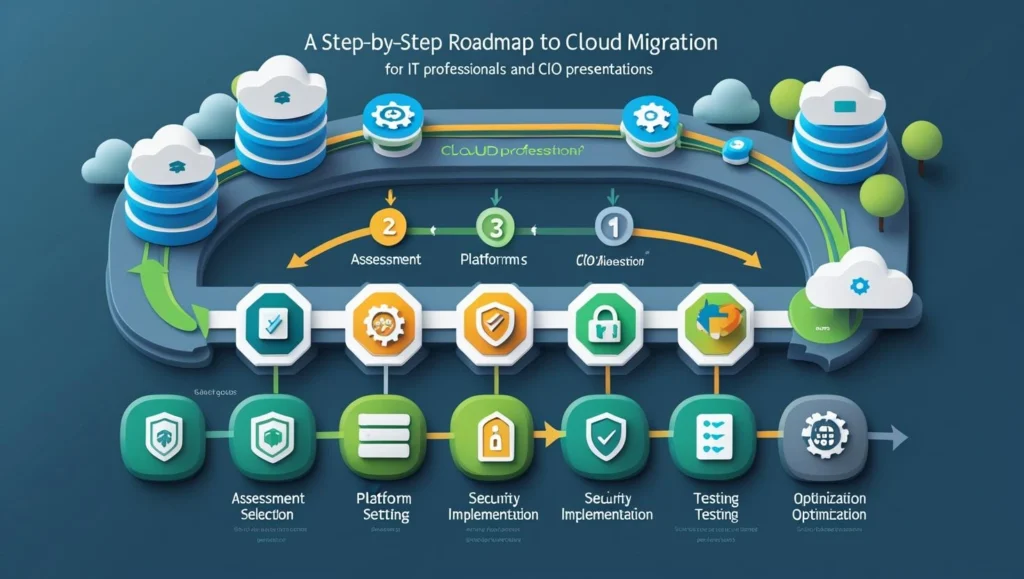Cloud migration is no longer a trend—it's a necessity. As enterprises worldwide transition from legacy systems to scalable, cloud-based platforms, they unlock enhanced agility, innovation potential, and cost efficiency. From SMBs to Fortune 500 companies, the move to cloud platforms like AWS and Azure is reshaping how business IT infrastructure is deployed, managed, and optimized.
Whether your company is exploring a full cloud transformation or adopting a hybrid model, having a clear, actionable IT cloud migration strategy roadmap is vital. This guide provides a structured overview to help IT decision-makers plan and execute successful migrations, minimize disruption, and position their organizations for long-term growth in the digital economy.
Understanding Cloud Migration and Its Challenges
Cloud migration involves moving digital assets—including data, applications, services, and IT processes—from on-premises infrastructure to public, private, or hybrid cloud environments. This transition enables organizations to scale resources on demand, reduce overhead costs, and leverage the latest innovations in AI, automation, and cybersecurity.

However, despite its benefits, migration presents several challenges:
| Challenge | Explanation |
|---|---|
| Data security | Transferring sensitive data raises compliance and encryption concerns. |
| Downtime | Interruptions during migration can disrupt business operations. |
| Compatibility | Legacy applications may require refactoring or replacement. |
| Vendor lock-in | Over-reliance on one provider may limit flexibility. |
These risks necessitate a carefully planned cloud migration strategy roadmap to ensure a smooth, secure transition.
Step-by-Step IT Cloud Migration Strategy Roadmap
An effective roadmap involves a combination of planning, execution, and optimization phases. Let’s explore each step in detail:
1. Assess Current Infrastructure and Business Needs
Begin with a comprehensive audit of your existing IT landscape. Identify:
- All applications, data repositories, and virtual machines (VMs).
- Critical workloads, compliance-sensitive systems, and dependencies.
- Business objectives such as cost reduction, operational agility, or scalability.
Use tools like AWS Migration Evaluator or Azure Migrate for automated infrastructure assessment.
2. Choose the Right Cloud Platform: AWS vs Azure
The two dominant players—Amazon Web Services (AWS) and Microsoft Azure—offer enterprise-grade solutions:
- AWS: Known for flexibility, mature services, and deep ecosystem. Ideal for startups, developers, and enterprises.
- Azure: Preferred by enterprises using Microsoft tools (Windows Server, Active Directory, Office 365).
Consider hybrid or multi-cloud setups if you want to avoid vendor lock-in. Evaluate costs using each provider’s pricing calculator.
3. Define a Phased Migration Approach
A common method is the 6R framework:
- Rehost (Lift-and-shift): Move VMs without code change.
- Replatform: Make minimal changes to leverage cloud benefits.
- Repurchase: Replace with SaaS options.
- Refactor: Redesign apps using cloud-native architectures.
- Retire: Decommission obsolete resources.
- Retain: Keep some assets on-premise.
Plan your cloud migration in logical phases. Start with non-critical workloads before scaling to complex systems.
4. Ensure Cloud Security and Compliance
Cloud security is a shared responsibility:
- Use IAM (Identity and Access Management) policies.
- Encrypt data at rest and in transit using AWS KMS or Azure Key Vault.
- Configure firewalls, DDoS protection, and data loss prevention tools.
- Comply with GDPR, HIPAA, and ISO standards depending on your region.
5. Execute and Test
Leverage automated migration tools:
- AWS Database Migration Service
- Azure Site Recovery
- CloudEndure Migration
After migration, conduct:
- Unit, integration, and regression testing.
- Load and stress tests.
- Security audits and cost analysis.
Monitor performance using CloudWatch (AWS) or Azure Monitor.
6. Optimize Post-Migration Environment
Cloud optimization is continuous. Key practices include:
- Right-sizing instances to reduce costs.
- Auto-scaling to meet changing demand.
- Resource tagging for cost tracking and organization.
- Use FinOps principles for cost governance.
Explore external guides like Google Cloud’s cost optimization tips to further refine efficiency.
Hiring Cloud Experts: When and Why
Sometimes, internal teams may lack the experience needed for a secure and efficient cloud migration. That’s where hiring professionals becomes invaluable.
Benefits of Hiring Cloud Experts:
- Faster Deployment: Reduce downtime and missteps.
- Best Practices: Leverage certified expertise on AWS, Azure, or multi-cloud strategies.
- Security: Ensure compliance and optimal configurations from the start.
- Customization: Tailor the migration roadmap to your unique business goals.
When evaluating consultants or agencies, look for:
- Certifications (e.g., AWS Certified Solutions Architect, Microsoft Certified Azure Administrator).
- Proven migration case studies.
- Experience with security, compliance, and DevOps practices.
How to Migrate to Cloud? Best Practices
To ensure a seamless migration, adopt the following best practices:
- Document Everything: Maintain runbooks, templates, and architectural diagrams.
- Communicate Clearly: Align stakeholders, developers, and users at every phase.
- Perform Dry Runs: Test migration processes in sandbox environments.
- Automate Where Possible: Use infrastructure-as-code (IaC) tools like Terraform or AWS CloudFormation.
- Establish Rollback Procedures: Have contingency plans in case of failure.
Following these practices minimizes disruption and accelerates adoption.
Navigating AWS Documentation and Other Cloud Resources
Comprehensive documentation and learning portals are available to help guide your cloud journey:
AWS Documentation:
Azure Resources:
Other Tools:
- Cloud Adoption Frameworks
- Migration checklists
- GitHub repositories with migration scripts
- Certification courses on Coursera, Udemy, or Pluralsight
These navigational tools help both technical and business users execute robust strategies confidently.
Global Perspective and Future Outlook
Cloud migration is a global movement—accelerated by the pandemic, remote work trends, and digital transformation. Organizations in the USA, Europe, Asia-Pacific, and beyond are adopting:
- Multi-cloud strategies for redundancy and resilience.
- Edge computing to reduce latency and enable real-time applications.
- AI and ML integrations to derive deeper insights from cloud-hosted data.
As more industries embrace cloud-first or cloud-native models, the demand for skilled cloud architects, DevOps professionals, and cybersecurity specialists will rise accordingly.
Internal Resource: Related Reading
For a look at how robotics and automation tie into modern cloud infrastructure, check out our guide on the Robotics Tech Roadmap for 2025–2030.
Conclusion
Migrating to the cloud is more than a technical shift—it’s a strategic transformation. With the right cloud migration roadmap, businesses can reduce costs, scale operations globally, and unlock innovation.
Whether using AWS, Azure, or a hybrid environment, success lies in detailed planning, strong security practices, continuous optimization, and seeking expert guidance when needed. As the cloud ecosystem matures, organizations that adopt early and plan smartly will lead the charge in the digital economy.







